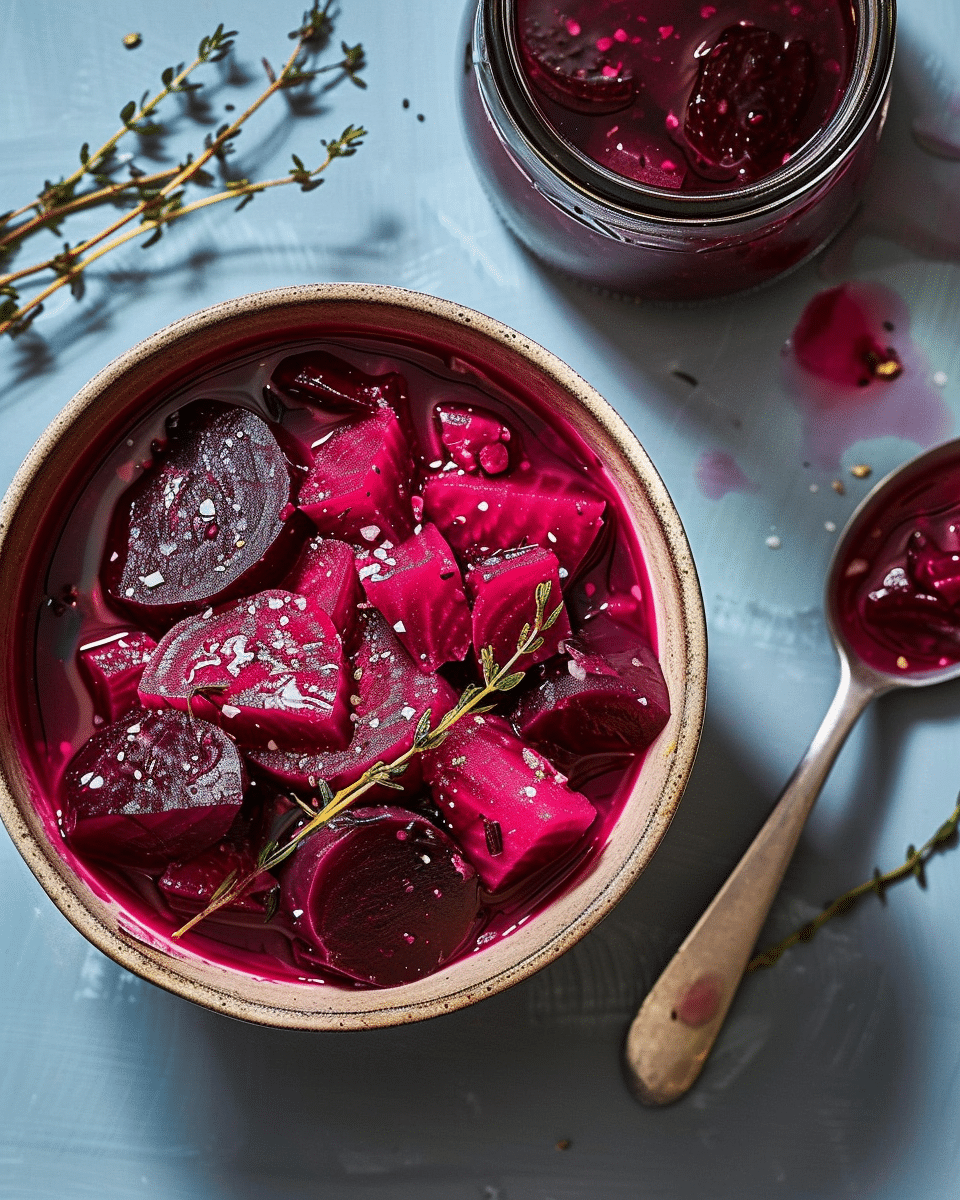Why You’ll Love This Recipe
Fermented beets are packed with probiotics, which promote gut health and digestion. They also retain their rich, earthy flavor and vibrant color through the fermentation process. Whether you’re looking for a tangy addition to salads, a side dish, or a snack, this homemade recipe is a simple way to incorporate fermented foods into your diet.
Ingredients
-
1 1/2 pounds beets (about 2 large)
-
2 to 3 cups room temperature filtered water (non-chlorinated)
-
2 tablespoons kosher salt or sea salt (not iodized)
-
3 to 4 teaspoons dried thyme
-
1 to 2 garlic cloves, smashed (optional)
-
5 peppercorns
(Tip: You’ll find the full list of ingredients and measurements in the recipe card below.)
Directions
-
Prepare the Equipment
Ensure your hands, jars, tools, and work surface are clean to avoid contamination during fermentation. -
Prepare the Beets
Scrub the beets thoroughly. Remove the tops and root ends. Peel the beets if desired. Cut the beets into 1/2-inch dice or chunks, or slice them into 1/4-inch thick pieces. -
Make the Brine
In a large measuring cup, combine the filtered water and salt. Stir until the salt is fully dissolved. -
Assemble the Jar
In a wide-mouth quart-size mason jar or two 1-pint jars, pack the beets along with the thyme, garlic, and peppercorns. Leave at least 1 to 1 1/2 inches of headspace to accommodate the weight. -
Add the Brine
Pour the salted water over the beets, ensuring they are completely submerged. -
Weigh Down the Beets
Place a fermentation weight or a small resealable plastic bag filled with extra brine on top to keep the beets submerged. -
Seal the Jar
Cover the jar with an airlock lid if available. If not, secure a piece of cheesecloth over the jar with a rubber band, or screw the lid on loosely and remember to unscrew it periodically to release any built-up air. -
Fermentation Process
Place the jar on a baking sheet, shallow bowl, or pie plate to catch any spills or juice that might bubble over. Store the jar in a cool, dark place. During fermentation, the brine may become cloudy; this is normal and indicates fermentation is underway. After about a week, the brine should clear, signaling that fermentation is complete. -
Storage
Once fermentation is complete, place a tight-fitting lid on the jar. Store the fermented beets in the refrigerator, ensuring they remain completely submerged in their brine. They can be stored refrigerated for 1 to 2 months.
Servings and Timing
-
Yield: Approximately 1 quart of fermented beets
-
Prep Time: 15 minutes
-
Fermentation Time: 7 days
-
Total Time: 7 days and 15 minutes
Variations
-
Flavor Variations: Feel free to experiment with additional spices, such as dill or mustard seeds, for varied flavors.
-
Additional Vegetables: Add additional vegetables like carrots or celery for a mixed ferment.
-
Extra Kick: For a spicy version, add some chili flakes or a sliced jalapeño to the jar.
Storage/Reheating
-
Storage Tips: Keep the fermented beets in the refrigerator and ensure they remain fully submerged in brine to preserve their flavor and texture.
-
Reheating: Fermented beets are usually enjoyed cold or at room temperature, but you can warm them slightly if desired.
FAQs
How long does fermentation take?
Fermentation typically takes about 7 days, depending on your environment. The temperature should be cool and dark for the best results.
What should I do if the beets float?
If the beets float, simply place a weight or a small plastic bag filled with extra brine on top of the beets to keep them submerged.
Can I use other spices?
Absolutely! Feel free to experiment with various spices such as mustard seeds, dill, or even ginger to create your own unique flavor profile.
Why is my brine cloudy?
Cloudy brine is perfectly normal during the fermentation process and indicates that the fermentation is underway. As the beets ferment, the brine should eventually clear up.
How long can I store the fermented beets?
Fermented beets can be stored in the refrigerator for up to 2 months, as long as they remain submerged in their brine.
Conclusion
Fermented Beets are a delicious and healthy addition to any meal. With their earthy flavor and probiotic benefits, they can be used in salads, as a side dish, or just enjoyed as a tangy snack. Making your own fermented beets is easy and customizable, so feel free to experiment with flavors and enjoy the benefits of fermented foods in your diet.

Fermented Beets: Health Benefits and Recipe Guide
- Prep Time: 15 minutes
- Cook Time: 0 minutes
- Total Time: 7 days and 15 minutes
- Yield: 1 quart of fermented beets
- Category: Side Dish
- Method: Fermentation
- Cuisine: Various
- Diet: Vegan
Description
Fermented beets are a nutritious, probiotic-packed snack that are tangy, flavorful, and beneficial for gut health. This recipe provides an easy guide to making fermented beets at home.
Ingredients
1 1/2 pounds beets (about 2 large)
2 to 3 cups room temperature filtered water (non-chlorinated)
2 tablespoons kosher salt or sea salt (not iodized)
3 to 4 teaspoons dried thyme
1 to 2 garlic cloves, smashed (optional)
5 peppercorns
Instructions
- Ensure your hands, jars, tools, and work surface are clean to avoid contamination during fermentation.
- Scrub the beets thoroughly. Remove the tops and root ends. Peel the beets if desired. Cut the beets into 1/2-inch dice or chunks, or slice them into 1/4-inch thick pieces.
- In a large measuring cup, combine the filtered water and salt. Stir until the salt is fully dissolved.
- In a wide-mouth quart-size mason jar or two 1-pint jars, pack the beets along with the thyme, garlic, and peppercorns. Leave at least 1 to 1 1/2 inches of headspace to accommodate the weight.
- Pour the salted water over the beets, ensuring they are completely submerged.
- Place a fermentation weight or a small resealable plastic bag filled with extra brine on top to keep the beets submerged.
- Cover the jar with an airlock lid if available. If not, secure a piece of cheesecloth over the jar with a rubber band, or screw the lid on loosely and remember to unscrew it periodically to release any built-up air.
- Place the jar on a baking sheet, shallow bowl, or pie plate to catch any spills or juice that might bubble over. Store the jar in a cool, dark place. The brine may become cloudy; this is normal and indicates fermentation is underway. After about a week, the brine should clear, signaling that fermentation is complete.
- Once fermentation is complete, place a tight-fitting lid on the jar. Store the fermented beets in the refrigerator, ensuring they remain completely submerged in their brine. They can be stored refrigerated for 1 to 2 months.
Notes
Cloudy brine is normal and indicates that the fermentation is in progress.
If the beets float, place a weight or small plastic bag filled with extra brine on top to keep them submerged.
Fermented beets can be stored for up to 2 months as long as they remain submerged in the brine.
For added flavor, experiment with spices like mustard seeds, dill, or ginger.
For a spicy version, add chili flakes or a sliced jalapeño to the jar.
Fermented beets are usually enjoyed cold or at room temperature, but you can warm them slightly if desired.
Nutrition
- Serving Size: 1/4 cup
- Calories: 35
- Sugar: 4g
- Sodium: 300mg
- Fat: 0g
- Saturated Fat: 0g
- Unsaturated Fat: 0g
- Trans Fat: 0g
- Carbohydrates: 8g
- Fiber: 2g
- Protein: 1g
- Cholesterol: 0mg



